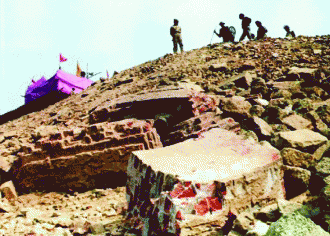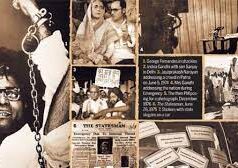
The ASI’s excavations and findings have conclusively answered the question raised in the Presidential Reference. The Allahabad High Court relied on the report and concluded that a Hindu temple existed
Some weeks ago, Chief Justice of India JS Khehar urged all parties to the Ayodhya dispute to work towards an amicable settlement and even offered his good offices to moderate an out-of-court settlement. Describing the issue as a matter that concerned “sentiments and religion”, the Chief Justice asked all parties to “give a bit, take a bit… make an effort to sort it out”. In his view the court should come into the picture only if such a settlement is not possible.
Given the sensitivity of the issue, it would indeed be ideal for all parties to move away from the court room and resolve the issue amicably via negotiations as suggested by the Chief Justice. However, many things have happened both within and outside the courts during the life of this long and seemingly intractable dispute, which are indeed non-negotiable. One such is the sovereign commitment made by the Government of India in the Supreme Court in September 1994, that if it was established that a Hindu temple or religious structure existed before the Babri Masjid, it would hand over the site to the Hindus.
A five-judge Bench of the Supreme Court delivered its judgement in the Faruqui case (M Ismail Faruqui and Others Vs Union of India and Others) in October 1994. While doing so, it simultaneously disposed off the Presidential Reference that had been made the previous year under Article 143(1) of the Constitution. In that reference the President asked the court the following question: “Whether a Hindu temple or any Hindu religious structure existed prior to the construction of the Ram Janmabhoomi-Babri Masjid (including the premises of the inner and outer courtyards of such structure) in the area on which the structure stood?” The court declined to answer this question. It said the question posed by the President was “superfluous and unnecessary and does not require to be answered”.
In the Faruqui case, the constitutional validity of Acquisition of Certain Areas at Ayodhya Act, 1993, was challenged. The court upheld the Act but declared Section 4(3) of the Act, which provided for abatement of all pending suits and legal proceedings pertaining to the disputed structure, to be invalid. This resulted in the revival of all pending suits and legal proceedings before the Allahabad High Court.
The Presidential Reference said a dispute has arisen whether a Hindu temple or a Hindu religious structure existed prior to construction of the masjid and that the Government proposed to settle the said dispute “after obtaining the opinion of the Supreme Court of India”. Those representing Muslim interests said the reference was purely academic and served no constitutional purpose.
The Supreme Court asked the Solicitor General to respond to these arguments. The Solicitor General made a written statement on behalf of the Government of India on September 14, 1994, in response to the court’s query. He spoke of the significance of the Presidential Reference and said that the Government would treat the court’s opinion on the question of fact raised in the reference as “final and binding”. Further, the Government was confident that the opinion of the Supreme Court “will have a salutary effect on the attitudes of the communities and they will no longer take conflicting positions on the factual issue settled by the Supreme Court”.
More significantly, the Solicitor General told the court that if efforts at a negotiated settlement do not succeed, the Government was committed to enforce the solution in the light of the Supreme Court’s opinion and consistent with it. The Government’s action in this regard will be even handed in respect of both communities. “If the question referred is answered in the affirmative, namely, that a Hindu temple/structure did exist prior to the construction of the demolished structure, Government action will be in support of the wishes of the Hindu community.
If, on the other hand, the question is answered in the negative, namely, that no such Hindu temple/structure existed at the relevant time, then Government action will be in support of the wishes of the Muslim Community.” The Solicitor General’s statement formed a part of the record and was taken into account by the court.
The Narasimha Rao Government gave this commitment because Muslim leaders had told the Government that they would voluntarily hand over the site to the Hindus if the existence of a temple below the Babri structure was established. The White Paper put out by the Rao Government after the demolition of the masjid had incorporated this fact. Since everything seemed to revolve around the answer to this question, this became the central issue in the negotiations between the Vishwa Hindu Parishad and the All India Babri Masjid Action Committee. The Government felt that everything would fall in place, once this pivotal question was answered. Hence the Presidential Reference.
However, while the Supreme Court declined to answer the question, the Allahabad High Court ordered the Archaeological Survey of India (ASI) to excavate the site and tell the court whether a Hindu temple or religious structure existed below the destroyed masjid. The ASI conducted extensive archaeological investigations at the site and submitted a comprehensive report to the Allahabad High Court. It said: “Viewing in totality and taking into account the archaeological evidence of a massive structure just below the disputed structure and evidence of continuity in structural phases from the tenth century onwards up to the construction of the disputed structure along with the yield of stone and decorated bricks as well as mutilated sculpture of divine couple… are indicative of the remains which are distinctive features found associated with the temples of North India.”
In other words, the ASI’s excavations and findings have conclusively answered the question raised in the Presidential Reference. Further, following this overwhelming evidence, all the three judges on the Lucknow Bench of the Allahabad High Court which heard the Ayodhya case, relied on the ASI’s report and concluded that a Hindu temple existed below the disputed structure.
The Government’s solemn assurance before the Supreme Court, the overwhelming archaeological and scientific evidence presented before the Allahabad High Court on the existence of a temple below the disputed structure and the opinion of all the three judges of that court are all facts which just cannot be wished away. They will have to be central to an eventual settlement, but as Chief Justice of India JS Kehar has suggested, a negotiated out-of-court settlement will be ideal.
By A Surya Prakash
(The writer is Chairman, Prasar Bharati. Views expressed here are personal)
Courtesy: The Pioneer














